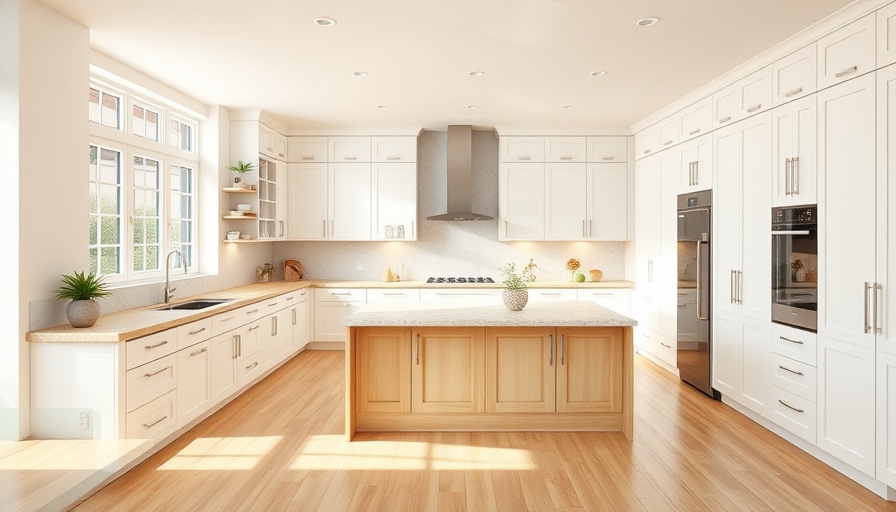
Understanding the Kitchen Renovation Costs in Johannesburg
Embarking on a kitchen renovation journey in Johannesburg can be an exciting yet daunting task, primarily due to the uncertainty about costs. Many homeowners are overwhelmed with vague estimates like 'it depends,' which can lead to sticker shock once projects begin. As we approach 2025, it's pivotal to provide clarity on what you should realistically expect to pay for kitchen renovations in the bustling areas of Johannesburg.
Realistic Cost Estimates for 2025
From budget transformations to luxurious upgrades, here’s a breakdown of the anticipated costs that Johannesburg homeowners will face:
-
Budget-Friendly Renovation: R45,000 - R80,000
- Basic cupboard refresh
- Laminate countertops
- Standard appliances and minimal layout changes
-
Mid-Range Renovation: R80,000 - R180,000
- Quality built-in cupboards
- Granite or engineered stone countertops
- Some layout modifications with decent appliances
-
Premium Renovation: R180,000 - R350,000
- Custom cabinetry
- Premium granite or quartz surfaces
- Major layout changes
- High-end appliances and finishes
-
Luxury Transformation: R350,000+
- Designer elements and imported materials
- Complete structural changes
- Smart home integration features
In fast-developing areas like Sandton, Fourways, and Randburg, homeowners often find themselves spending between R120,000 and R220,000. The right renovation can significantly enhance their home’s marketability and living quality.
Where Do Your Renovation Dollars Go?
Understanding where your money goes can help you allocate your budget effectively:
-
Kitchen Cupboards & Cabinetry (30-40% of Budget)
- Melamine Cupboards: R3,500 - R6,000 per linear meter
- Polyurethane Cupboards: R6,500 - R12,000 per linear meter
- Solid Wood Cupboards: R10,000 - R18,000+ per linear meter
-
Countertops (20-30% of Budget)
- Granite: R1,500 - R3,500 per square meter
- Engineered Quartz: R2,200 - R4,500 per square meter
- Laminate: R450 - R900 per square meter
-
Labour & Installation (25-35% of Budget)
- Carpentry Labour: R350 - R550 per hour
- Plumbing & Electrical: R450 - R800 per hour
- Average plumbing and electrical needs lead to R35,000 - R65,000 total for installation.
-
Appliances (10-20% of Budget)
- Built-in ovens: R4,500 - R18,000
- Dishwashers: R6,000 - R25,000
Timely Renovation Strategies
Here are some smart strategies that homeowners can adopt to stretch their budgets:
- Keep the Layout: Retaining the existing layout can save you significant plumbing and installation costs.
- Mix Quality Materials: Focus premium materials on focal points while using budget-friendly alternatives in lesser-used areas.
- Local Materials: Opt for local granite to save costs without compromising aesthetics.
- Time Your Renovation: Scheduling renovations during off-peak months can lead to better pricing and increased availability from contractors.
Understanding the nuances of the Johannesburg kitchen renovation market is key for homeowners planning their next upgrade.
Maximizing The Return on Your Investment
In the Johannesburg property market, a well-executed kitchen renovation not only enhances day-to-day living but also provides a strong return on investment, often between 70-85%. Key areas to focus on for maximum ROI include:
- Quality Countertops: Buyers favor natural stone.
- Functional Design: Features like soft-close cabinets and under-cabinet lighting add perceived value.
- Timeless Aesthetics: Neutral colors create broad appeal and make future selling easier.
The Path Forward: Your Renovation Roadmap
As you stand on the threshold of this transformative journey, keep the following steps in mind:
- Define a realistic budget accounting for contingencies.
- Source multiple quotes to ensure competitive pricing.
- Vet contractors thoroughly for licensing and work quality.
- Be prepared for some disruption and have a contingency plan for meals.
Investing in a kitchen that resonates with you and functions well for your needs is undoubtedly worth it. With careful planning, the process can be smooth and rewarding, ensuring your renovation reflects your vision without unexpected financial setbacks.
 Add Row
Add Row  Add
Add 




Write A Comment